Sunday, April 19th 2020

TSMC 3nm Process Packs 250 Million Transistors Per Square Millimeter
Imagine being able to shrink a Pentium 4 processor die to the size of a pin-head (if you can figure out how to place 478 bumps on it). TSMC revealed that its future 3 nanometer silicon fabrication node has a development target of 250 million transistors per mm². Called N3, the next-generation silicon fabrication node succeeds TSMC's N5 family of 5 nm-class nodes (that's N5 and any possible refinements).
TSMC CEO CC Wei confirmed that development of the 3 nm node is on-track, with risk production scheduled for 2021 and volume production commencing in the second half of 2022. Perhaps the most startling revelation is that TSMC has decided to stick with FinFETs for N3 owing to the maturity of the technology. Experts are of the opinion that sub-5 nm nodes will require major innovations with materials and structures. TSMC claims that N3 will provide a 10-15% speed improvement at iso-power or 25-30% power reduction at iso-speed, compared to N5.
Source:
WikiChip Fuse
TSMC CEO CC Wei confirmed that development of the 3 nm node is on-track, with risk production scheduled for 2021 and volume production commencing in the second half of 2022. Perhaps the most startling revelation is that TSMC has decided to stick with FinFETs for N3 owing to the maturity of the technology. Experts are of the opinion that sub-5 nm nodes will require major innovations with materials and structures. TSMC claims that N3 will provide a 10-15% speed improvement at iso-power or 25-30% power reduction at iso-speed, compared to N5.

32 Comments on TSMC 3nm Process Packs 250 Million Transistors Per Square Millimeter
It will be interesting see these two companies take different approaches with roughly the same timescales, although Samsung has yet to make me believe they can deliver.
Intel leadership did not do any good. It brang stagnation to the company.
They just kept giving us quad core after quad core. If we were lucky we got a 5% boost from one generation to the next!
Watching Intel running around trying to caught up is great, I think Rocket Lake and Alder Lake won't be too bad, they will keep AMD within reaching distance, until Intel can get a proper new CPU out on their 7nm process. Then we will see some competition again.
Zen 2 @ 7nm --> [N5 +15% perf -> N5P +7% perf] = Zen 3
14nm++++++++++++++ is big, and insanely power hungry. It's also questionable if it'll keep a clock advantage over TSMC's N5P EUV.
10nm and 10nm+ are a bit less power hungry, but hit the same kind of clocks that GF 14nm did.
7nm ain't shipping in 2021. Wouldn't be surprised if it's late 2022 now (Covid-19 blamed). Whilst it's expected to clock better than Intel 10nm, I don't think it's expected to get anywhere near 14nm+++++++, so TSMC will probably have a significant clock lead on N5P (or 3nm depending on when Intel 7nm ships).
Can only see it getting worse for Intel, until Keller's new architecture debuts in 2023 or later.
I would love Zen 4 to land in 2021 but I can't see that happening with the delays Zen 3 is having plus the power issues 5nm appears to have currently.
In any case it doesn't seem to matter how fast Intel comes back. They have a tight grip on the OEM market apparently regardless of competition.
I fully believe Intel will be back, I am really glad AMD have and are having such a great run. I think it's in AMD's hands as to who wins for the next 2 years but starting in 2022 Intel will have some good CPUs again and it will be down to how well AMD have released Zen 3 and Zen 4 and what kind of performance lead they have managed to create during this Intel restructuring phase as to whether Intel can walk straight back into the lead again or whether they need to battle for it.
I would be willing to bet that by the end of 2024 the status quo has returned and Intel has the best best chips in most segments for most workloads though.
The only thing that I can see upsetting this is if AMD manages to nail monster APUs, like I mean proper beasts though. Basically a chip double what the Xbox Series X is but using Zen 4 and RDNA 3.0 on 5nm and with 32GB of HBM3 as the unified system and graphics memory.
If Intel is behind or out of the race, we only have two competitors left and one of them has not had a good track record lately either.While I agree with the point, you are looking at the wrong competition. When we talk about semiconductor manufacturing (in a thread about 3 nm process on TSMC's roadmap) its TSMC, Samsung and Intel. All of them are putting $10+ billion yearly into R&D and really more in tune of $15 billion. We are not going to get new competitors into that easily.
We all know the state of TSMC and Intel. Samsung has been kind of there with SoCs and seems to get its ducks in a line for 7nm process, albeit quite late. Their presence in high-performance manufacturing has been weak though.
Intel: <runs away shouting random nonsense>
Not quite running away.